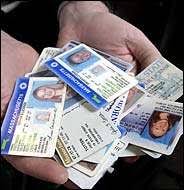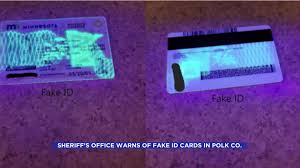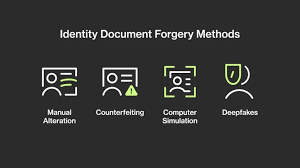Fake IDs
Introduction: Unveiling the Intrigue Behind Fake IDs
Fake IDs have long held a sense of allure in society, from rebellious teenagers hoping to sneak into bars and nightclubs, to more serious forms of identity fraud and crime. But behind the often-glamorized stories of "getting away with it" lies a vast underground industry that is both illegal and dangerous. While pop culture often depicts the act of obtaining a fake ID as an exciting rite of passage, the true nature of these counterfeit documents carries significant risks.
In this in-depth exploration, we’ll examine the historical roots of fake IDs, the evolution of technology that enables their creation, the legal consequences of using them, and how modern society navigates this delicate terrain. We'll also delve into the reasons why individuals seek out fake IDs, whether for personal freedom, privacy, or nefarious activities, and analyze how governments and law enforcement are responding to the growing threat of counterfeit identification.
Chapter 1: Historical Overview of Fake IDs
Fake IDs are not a new phenomenon; in fact, the concept of falsifying identity documents can be traced back to ancient civilizations where documents or tokens represented status, citizenship, or authority. During times of war, espionage, and revolution, fake identification often played a key role in covert operations. For example, during World War II, fake IDs helped resistance fighters move behind enemy lines, shielding their true identities. Similarly, in various oppressive regimes throughout history, forged papers have enabled individuals to escape persecution or live in secrecy.
In the modern context, fake IDs became particularly popularized during the 20th century, especially as stricter laws around drinking, voting, and personal identification were enacted. The creation and use of false identification became synonymous with underage drinking in the 1970s and 1980s in countries with strict alcohol consumption laws like the United States, where the legal drinking age is 21. Throughout this period, the act of creating fake IDs was largely a low-tech endeavor—often involving amateur efforts to alter or replicate physical identification cards using rudimentary techniques.
Chapter 2: Evolution of Fake ID Technology
The rapid pace of technological advancement in the 21st century has revolutionized the production and distribution of fake IDs. In the past, creating a convincing counterfeit required a certain level of manual skill and access to materials that resembled official government documents. Today, sophisticated digital tools, high-quality printers, and advanced forgery techniques allow for the creation of fake IDs that are nearly indistinguishable from legitimate ones.
2.1 Modern Tools and Techniques
One major innovation has been the use of holographic overlays and microprinting to mimic the security features on government-issued IDs. Criminal organizations and illicit markets often exploit the availability of advanced printing technology to reproduce these intricate details with shocking precision. Additionally, the rise of online marketplaces and the Dark Web has made fake IDs more accessible, with websites advertising high-quality forgeries that can be shipped directly to customers around the world.
The digital nature of modern society has also led to the creation of fake digital identities—such as fraudulent social security numbers, fake biometric data, or falsified digital driver’s licenses stored in apps. As governments shift to digital forms of identification, forgers have adapted, using software to manipulate data and create electronic profiles that evade detection.
2.2 Blockchain and the Future of Identity Verification
Governments and businesses are increasingly turning to blockchain technology as a potential solution to counteract the proliferation of fake IDs. Blockchain, with its decentralized and tamper-proof ledger, promises to create a system where every identity is verified against a secure digital record. This could potentially revolutionize how identification is managed globally, making it far more difficult for counterfeiters to produce fake documents. However, blockchain adoption for identity verification is still in its infancy and presents challenges related to privacy, accessibility, and implementation costs.
Chapter 3: Market Analysis: The Underground Economy of Fake IDs
3.1 Global Demand for Fake IDs
The demand for fake IDs varies greatly across regions and demographics. In countries with strict age-based laws for purchasing alcohol, entering clubs, or even obtaining driver's licenses, young people often seek out counterfeit identification as a way to bypass these legal restrictions. This demand fuels a thriving underground market, with many vendors operating through discreet websites or even social media platforms. Some fake ID producers are highly organized and resemble sophisticated businesses, offering customer support, guarantees, and bulk order discounts.
However, the market for fake IDs is not limited to underage drinkers. Criminal organizations, fugitives, and people involved in fraudulent activities often rely on fake identification to carry out more serious crimes, including identity theft, human trafficking, and financial fraud. This has drawn the attention of law enforcement agencies worldwide, which are working to dismantle these underground networks.
3.2 Key Players and Regions
Some regions have become notorious for producing fake IDs, often due to lax regulations, corruption, or access to sophisticated technology. Certain areas in Asia, Eastern Europe, and Latin America are particularly known for their production of counterfeit documents, which are then sold on a global scale. These operations range from small-scale local forgers to larger organized crime rings that produce fake IDs as part of a broader portfolio of illegal activities.
In the U.S. and Europe, most buyers tend to be young adults, while in regions with political instability, the use of fake IDs is often linked to more serious offenses, such as escaping persecution or entering countries illegally.
Chapter 4: Legal Risks and Consequences
4.1 The Criminal Implications of Fake ID Use
Possessing or using a fake ID may seem like a minor offense in some contexts, but the legal consequences can be severe. In most jurisdictions, the production, distribution, or use of fake identification is a crime punishable by fines, imprisonment, or both. In the United States, for example, being caught with a fake ID can result in misdemeanor or felony charges, depending on the circumstances. While underage individuals using fake IDs to enter bars or purchase alcohol might face relatively light punishments, individuals using fake identification for more serious crimes—such as financial fraud, identity theft, or illegal immigration—can face years of imprisonment.
The consequences for producing or selling fake IDs are even more severe. Those involved in the creation or distribution of counterfeit IDs can face hefty fines, long-term imprisonment, and even charges related to organized crime if their operation is linked to larger criminal activities.
4.2 Law Enforcement and Fake ID Detection
As the quality of fake IDs improves, law enforcement agencies and businesses have had to invest in better detection methods. Some of the most advanced systems include barcode scanning, RFID chips, and databases that cross-check identification against government records in real-time. Additionally, security features like UV printing, laser engraving, and complex microprinting are becoming standard on many official IDs to prevent forgery.
However, counterfeiters often find ways to stay ahead of these security features, leading to an ongoing technological arms race between law enforcement and forgers. The international nature of the fake ID trade also presents challenges, as many forged documents are produced in one country and used in another, complicating efforts to track and prosecute offenders.
Chapter 5: The Ethics of Fake IDs: Beyond the Law
While the legal consequences of fake IDs are clear, the ethical dimensions are more nuanced. For some, the use of a fake ID is a harmless act—a way for underage individuals to enjoy a night out or bypass arbitrary age restrictions. Others argue that it is a slippery slope, normalizing deception and dishonesty, and potentially leading to more serious forms of identity fraud later in life.
5.1 Personal Freedom vs. Societal Rules
One ethical question surrounding fake IDs is whether individuals should have the right to bypass laws they consider unjust or arbitrary. For example, in countries where the legal drinking age is set relatively high, some argue that using a fake ID to purchase alcohol is a form of personal freedom and autonomy. However, laws exist for a reason, and circumventing them—whether they are seen as fair or not—can have broader societal implications, such as promoting lawlessness or encouraging risky behavior.
5.2 Identity and Privacy Concerns
In an era where identity is increasingly tied to digital records and surveillance, the desire for privacy can sometimes fuel the demand for fake IDs. Some individuals seek to create alternate identities as a way to protect their personal information from being tracked or exploited by governments, corporations, or criminals. While this may seem like a legitimate concern, creating fake identities can have serious consequences, especially when those identities are used to engage in illegal activities or deceive others.
Chapter 6: Target Audience Analysis
The target audience for fake IDs can be divided into several key demographics, each with its own motivations and needs. Understanding these groups can provide insight into the broader appeal of counterfeit identification and the risks involved.
6.1 Underage Consumers
The most common users of fake IDs are young adults who are not yet of legal age to partake in activities like purchasing alcohol, entering clubs, or gambling. This group typically seeks fake IDs as a means of enjoying social freedoms reserved for older individuals. In many cases, these users view fake ID possession as a temporary solution until they reach the legal age, with little concern for the potential legal risks involved.
6.2 Privacy-Conscious Individuals
In today’s digital world, some individuals are concerned about their personal data being collected, tracked, or exploited. As a result, they may seek out fake identification to avoid leaving digital footprints or to create secondary personas for online interactions. These users tend to be more concerned with privacy than with breaking the law, although their actions can still have legal repercussions.
6.3 Criminals and Fraudsters
A more dangerous group of fake ID users are those who seek counterfeit identification for the purpose of committing fraud, theft, or other crimes. This demographic includes identity thieves, scammers, and individuals involved in more serious criminal enterprises. Fake IDs allow these users to mask their true identities, making it difficult for law enforcement to track their activities.
Conclusion: The Complex Landscape of Fake IDs
Fake IDs are more than just tools for underage individuals trying to gain entry into clubs—they are part of a much larger and more complex issue that touches on privacy, freedom, and crime. The creation and use of fake IDs represent a fascinating intersection of technology, law, and ethics, revealing how society grapples with the balance between individual autonomy and collective security.
As technology continues to evolve, the battle between fake ID producers and law enforcement will likely intensify. However, the ethical questions surrounding fake IDs—about the nature of identity, privacy, and the limits of personal freedom—will remain unresolved for years to come.
 Discreet ID Services
Discreet ID Services
 Custom Fake IDs
Custom Fake IDs
 Fake ID benefits
Fake ID benefits
 FlorFake IDa
FlorFake IDa
 Fake ID Features
Fake ID Features
 Secure Fake IDs
Secure Fake IDs
 Where to Buy Kansas Fake ID
Where to Buy Kansas Fake ID
